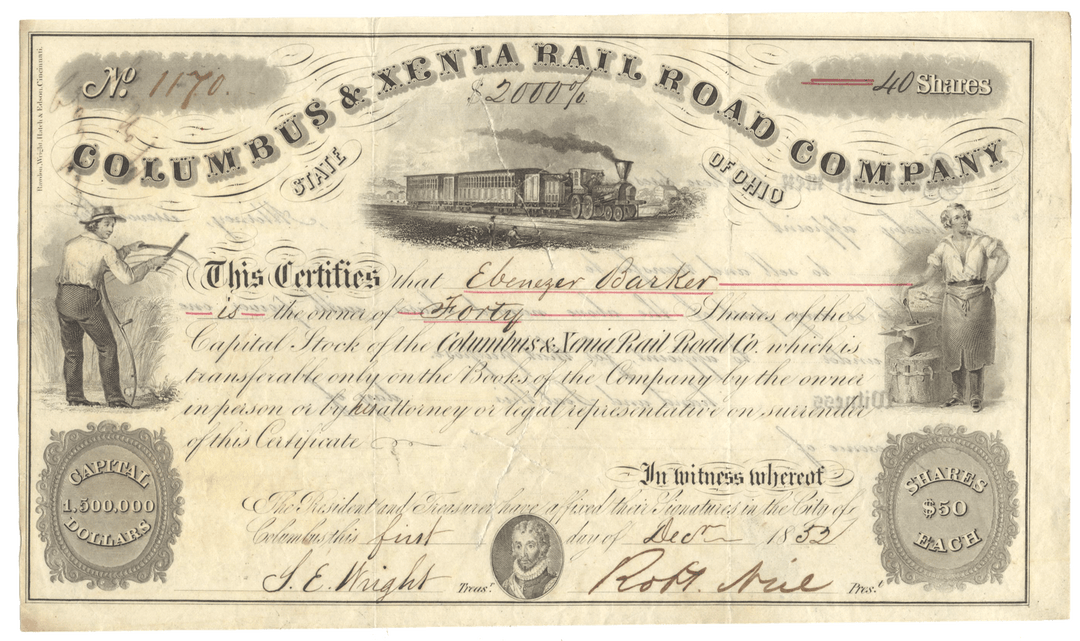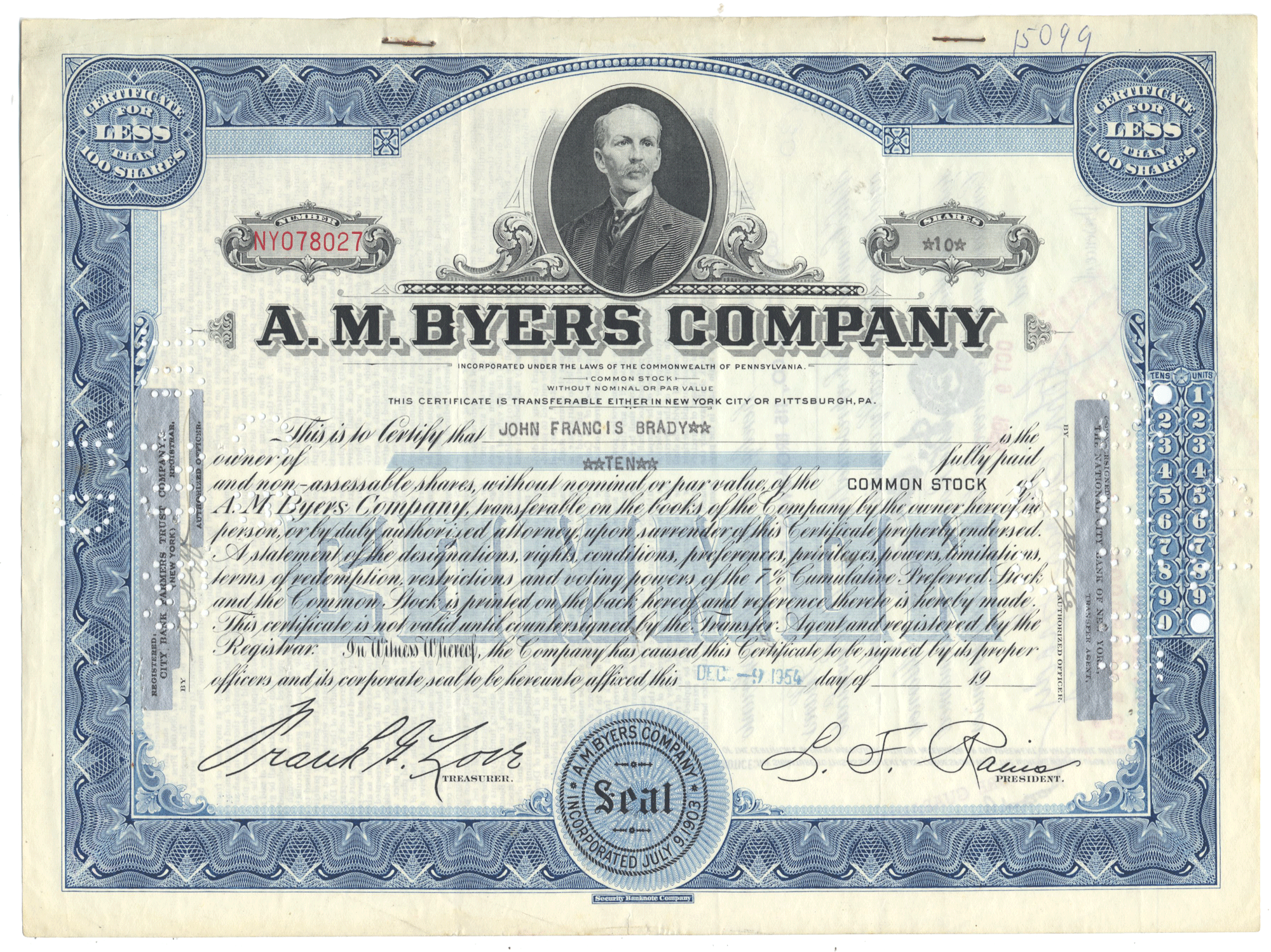
Columbus & Xenia Rail Road Company
- Guaranteed authentic document
- Orders over $75 ship FREE to U. S. addresses
Product Details



Columbus & Xenia Rail Road Company
Certificate Type
Capital Stock
Date Issued
December 1, 1852
Canceled
Yes
Printer
Rawdon, Wright, Hatch & Edson
Signatures
Hand signed
Approximate Size
9 1/8" (w) by 5 1/4" (h)
Additional Details
"X" cut cancels in body
Historical Context
As work progressed moving the Little Miami Railroad north from the banks of the Ohio River, thought was given to where those rails would lead.
The original intention was to connect with the Mad River & Lake Erie at Springfield (Clark Co.) but the collapse in the price of railroad stocks in the Panic of 1837 brought an air of uncertainty to this and other once promising proposals just a few years before. In Ohio this uncertainty was increased by a prohibition on stock subscriptions by municipal corporations such as that which had been used to fund the Little Miami.
Still, the period witnessed an explosion in the number of projects suggested, with some actually progressing past the financing stage to construction. By March 1844, the Little Miami had weathered the financial storms and was rapidly building north toward Morrow. The Mad River & Lake Erie was having a little more difficulty. Projects developing new, more promising overland routes with the east coast were diverting capital from the MR&LE, whose connections east would be by regular steamer service between Sandusky, Ohio and Buffalo, New York.
As 1844 began Cleveland was coming into its own as the major port on the southern shore of Lake Erie and Columbus was growing in importance as the Buckeye State's capital. A company calling itself the Cleveland, Cincinnati, St. Louis and Chicago Railway Company, better known by its later name Cleveland, Cincinnati & St. Louis Railway -- The Big Four -- was building a line south from Cleveland to the other cities of its name. Other companies were extending their lines west toward the growing port of Cleveland. A simple understanding of geography was all that was needed to realize that these routes were where the future laid.
In his idosyncratic, self-published book "The Little Miami Railroad," Robert Loundsberry Black wrote that the Springfield City Council rebuffed overatures from the Little Miami Railroad Company and other potential investors wanting to connect Springfield and the LMRR with Columbus. The atmosphere was more conducive in Xenia. On March 12, 1844, only eight years and one day after the chartering of the Little Miami RR, the Columbus & Xenia Railroad Company was incorporated. Its purpose was to build a single- or double-tracked railline between the Columbus and Xenia by the best route available.
The Little Miami completed its line to Springfield in 1846 and began waiting for the MR&LE. It would be 1848 before Ohio's first cross-state line was complete. "By the time the MR&LE finally reached Springfield, the C&X was already under contract, and soon had completed its entire route of 53 miles," James Shell writes in "Next Stop! Xenia." From Columbus the line ran west through West Jefferson and London in Madison County, South Charlestown in Clark County and Cedarville in Greene County to Xenia.
If, as Black suggests, that principals with the LMRR were involved with organizing the C&X, the cooperative relationship that quickly developed between the two lines is not surprising. As the line to Columbus opened, the Little Miami and the C&X "built a fine new 'union' passenger station where their lines met just south of downtown Xenia." Shell writes.
A return on the young companies' investment in good will was quick in coming. When the CC&C's line reached Columbus in 1851, it quickly agreed to use the tracks of the C&X and Little Miami and forego the expense of building and operating its own more direct to Cincinnati. In 1852 the Lakeshore Railroad, later a key element of the New York Central's "water level" route to Chicago, reached Cleveland and the CC&C line to Columbus. The C&X and Little Miami were now part of a transcontinental railroad route that by the middle of the century could transport people and goods more than 1,000 miles from the East Coast to the Mississippi River. In 1853, the two companies formalize the relations by entering into a partnership known as the Little Miami & Columbus & Xenia Railroad.
In 1854 the Dayton, Xenia & Belpre Railroad completed 16 miles of track between Dayton and Xenia. This gave the LM&C&X an entree to Indiana via the DX&B and Dayton & Western Railroad. In 1853 the D&W opened its line between Dayton and New Paris near the Indiana line where it met the the Richmond & Miami Railroad Company that connected with the Indiana Central Railroad in Richmond, Indiana.
In 1859, the LM&CX leased the Dayton, Xenia & Belpre. Six years later, in 1865, the partnership bought the 16-mile outright as it entered into a lease for the Dayton & Western that included the D&W's interest in the Richmond & Miami. In 1868 the Little Miami Railroad Co. and Columbus & Xenia Railroad Co. disolved their partnership and the Little Miami leased the C&X less than two years before it would meet the same fate - to the Pennsylvania Railroad Company and made part of its Pittsburgh, Cincinnati, Chicago & St. Louis Railway Company.
The rails laid down by the C&X would carry trains for nearly 150 years. Having survived the 1968 PRR-NYC merger creating Penn Central and the Penn Central's subsequent collpase and the 1974 formation of the Consolidated Rail Corp, Conrail, the line carried its last through freight in December 1984. Conrail sought abandonment of the C&X and DX&B lines between London and the site of the PRR's Clement Tower for lack of business. There were only three customers on a line between London and Dayton that parallelled Conrail's more profitable ex-NYC/Big Four line through Springfield. Conrail still uses the C&X route from Columbus to London.
Related Collections
Additional Information
Certificates carry no value on any of today's financial indexes and no transfer of ownership is implied. All items offered are collectible in nature only. So, you can frame them, but you can't cash them in!
All of our pieces are original - we do not sell reproductions. If you ever find out that one of our pieces is not authentic, you may return it for a full refund of the purchase price and any associated shipping charges.





